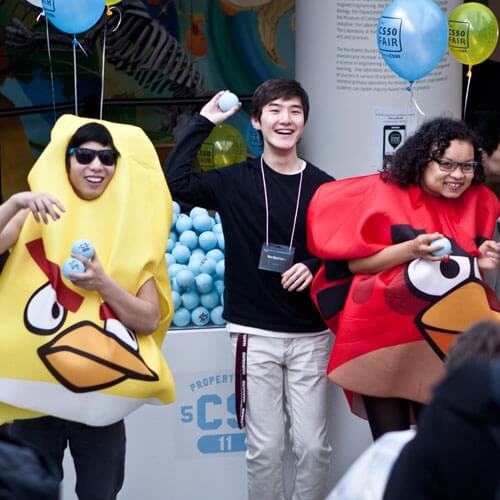News
Visitors to the CS 50 Fair on December 9 were welcomed—or, rather, pelted—with baby-blue stress balls, a startling but well-intentioned reminder that the fall semester had come to a close.
Visitors to the CS 50 Fair on December 9 were welcomed—or, rather, pelted—with baby-blue stress balls upon their arrival. This startling but well-intended greeting, by laughing students in Angry Birds costumes, was merely a hint of the bustle of crowds, music, candy, popcorn, and (of course) hundreds of laptops ahead.
The scene at the Northwest Science Building represented the culmination of the challenging, but highly social, introductory computer science course known as "CS 50."
Consistently one of the most popular undergraduate courses at Harvard, CS 50 defies convention. In fact, a large portion of the class had stayed up all night the previous weekend at the Microsoft-sponsored Hackathon. To resolve any last-minute bugs before their projects went live, students helped one another, aided by pizza at 8 p.m., Chinese at 1 a.m., and pancakes at 5 a.m. (for anyone still typing).
“It’s always striking, just how much they end up teaching themselves by semester’s end,” said instructor David Malan, a Senior Lecturer in Computer Science at the Harvard School of Engineering and Applied Sciences (SEAS). “Most of the projects here end up diving into some territory that we simply don’t cover in the class.”
CS 50 attracts students from all class years and backgrounds: 76 percent of enrolled students had never before taken a computer science course, 10 percent were students at Harvard Extension School, and—still remarkable in the field of computer science—35 percent were women.
Projects ranged from a tool that limits procrastination, to a website that displays longitudinal market capitalization data, and even an application that helps with music composition.
“With the final project we finally take the training wheels off and ask students to just go out and create something—anything—using whatever tools they like and using the skills that they’ve obtained over the course of the semester,” said Malan (A.B. ’99, S.M. ’04, Ph.D. ’07), who took CS 50 as an undergraduate at Harvard College. “It’s very rewarding. I remember it as a student, and it’s easy to see as a teacher now, looking at students, how excited they are when they get something to work. It’s amazing how gratifying it is when they finally go out and create something of their own.”
In past years, the class has given rise to many websites popular among students, including HarvardFML (a social complaint board) and ISawYouHarvard (a site for missed connections), and practical applications such as Shuttleboy (an app to help track the arrival of the next campus bus) and the course shopping tool (making managing potential schedules a breeze).
Inspired by what's come before, each new crop of students is encouraged to create projects that will benefit the campus community.
Nuseir Yassin ’14 drew inspiration for his project, Kindify, from the course itself. An economics concentrator, Yassin was fascinated by the way one act of kindness—for example, helping a classmate with a problem set—could set off a chain of helpful behavior throughout the class. Yassin created a “tree of kindness” that allows people to watch their kind acts spread, providing game-like incentives to connect with others in a network of goodwill.
Christine Chen ’14, an economics concentrator, and her partner Zijian Wu ’14 (molecular and cellular biology) worked to create change slightly farther afield. For their final project, they created a website for the Chinatown Citizenship Project, of which they are co-directors. The organization, affiliated with Harvard’s Phillips Brooks House Association, holds tutoring sessions in English, history, and civics for Chinese immigrants who are studying for the U.S. citizenship test.
“We wanted to use this as a publicity tool,” said Chen. “Our prospective students and tutors can find out more about us and get involved with us.”
Chen, who had very little experience in computer science before enrolling in CS 50, decided to take the leap because so many of her upperclassmen friends had recommended the course.
“I was a little scared, but David Malan did a really good job letting us know that a lot of us are inexperienced, so we feel like we’re not alone,” she said. “There are some really good resources, so we can manage it even without prior experience.”
Head teaching fellows Matt Chartier '12 and Rob Bowden '13, armed with iPads, coordinated a small army of 98 teaching fellows and course assistants to keep the office hours and homework assignments functioning smoothly.
Matthew Chartier '12, a computer science concentrator, is one of two head teaching fellows for the course, which enrolled 677 students this term. Photo by Eliza Grinnell.
“I’ve really gotten to see the fair develop from its inception to what we see here today,” said Chartier, who took the class as a freshman, three years ago. “It’s a way for all the students to share what they’ve worked on throughout the course (and especially in the last few weeks) with their friends from across the campus.”
More than anything, he said, the CS 50 Fair is a chance “for people to be able to come together and see what CS is all about—what computers empower people to create.”
Topics: Computer Science
Cutting-edge science delivered direct to your inbox.
Join the Harvard SEAS mailing list.



